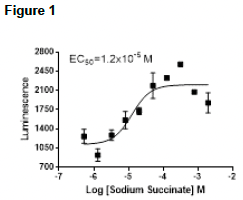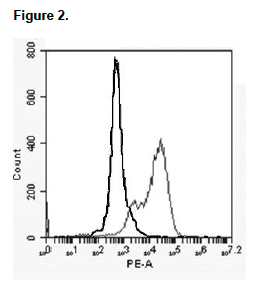Product Information
Catalog Number:
CA1141BA2-1
Lot Number:
CA1141BA2-1-032822
Quantity:
1 vial (2 x 106) frozen cells
Freeze Medium:
Cellbanker 2 (Amsbio 11891)
Host cell:
CHO-K1 β-Arrestin2
Transfection:
Expression vector containing full-length human GPR91 cDNA (GenBank Accession Number: NM_033050.3) with FLAG tag sequence at N-terminus and ARRB2 cDNA (GenBank Accession Number NM_004313.3)
Recommended Storage:
Liquid nitrogen upon receiving
Propagation Medium: DMEM/F12, 10% FBS, 10 μg/mL puromycin, 800 μg/mL G418
Stability: In progress
Data Sheet
Background: GPR91, also known as SUCNR1, is a G Protein-Coupled Receptor with 339 amino acids. It has been characterized as a receptor for Succinate, a citric acid cycle intermediate. Succinate plays a key role in energy metabolism. Local interstitial accumulation of Succinate has recently been reported to serve as an indicator of ischemic or diabetic organ damage in the brain, liver, and kidney. In diabetes patients, the accumulation of Succinate is detectable in the plasma, and more significantly in the renal tubular fluid and urine. It is therefore considered a potential new biomarker of local tissue damage. It has also been shown that Succinate increases blood pressure in animals. The Succinate-induced hypertensive effect involves the renin-angiotensin system that is shown to be absent in GPR91-deficient mice. There is a possible role for GPR91 in renovascular hypertension, a disease closely linked to atherosclerosis, diabetes and renal failure. In a recombinant system overexpressing GPR91, Succinate was shown to not only stimulate calcium mobilization and inositol phosphate (IP) accumulation through the stimulation of Gαq pathway but also to activate the Erk1/2 MAPK pathway and inhibit forskolin-stimulated cAMP accumulation through Gαi pathway
Application: Functional assays


Figure 1. Dose-dependent stimulation from arrestin recruitment upon treatment with ligand, measure with MULTISPAN™ β-Arrestin Assay Kit (Multispan MSBAK01). Figure 2.. Receptor expression on cell surface measured by flow cytometry (FACS) using an anti-FLAG antibody. Black line: parental cells; gray line: receptor-expressing cells.
References:
Ludwig, M.-G., Vanek, M., Guerini, D., Gasser, J. A., Jones, C. E., Junker, U., Hofstetter, H., Wolf, R. M., Seuwen, K. Proton-sensing G-protein-coupled receptors. Nature 425: 93-98, 2003.
Saxena, H., Deshpande, D., Tiegs, B., Yan, H., Battafarano, R., Burrows, W., Penn, R. (2012). The GPCR OGR1 (GPR68) mediates diverse signalling and contraction of airway
Saavedra et al. (1998) Blockade of brain angiotensin II AT1 receptors ameliorates stress, anxiety, brain inflammation and ischemia: Therapeutic implications. Psychoneuroendocrinology 36:1-18.
